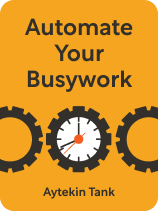

This article is an excerpt from the Shortform book guide to "Automate Your Busywork" by Aytekin Tank. Shortform has the world's best summaries and analyses of books you should be reading.
Like this article? Sign up for a free trial here.
What if you could eliminate the repetitive tasks that consume your workday? How much more could you accomplish if you focused primarily on meaningful, creative work?
In Automate Your Busywork, productivity expert Aytekin Tank reveals how to delegate routine tasks to digital systems. His approach helps professionals increase efficiency and dedicate more time to projects that truly matter.
Continue reading for an overview of this book that can transform your work life.
Overview of Automate Your Busywork
If you’re like most people, you probably believe that time-consuming tasks are simply part of your job—and that it’s not possible to focus primarily on meaningful, creative work unless you have a team of assistants to handle your routine duties.
But, what if there’s a way to eliminate much of the repetitive labor that consumes your day? In Automate Your Busywork, entrepreneur and productivity expert Aytekin Tank argues that, by leveraging automation tools, you can delegate routine tasks to digital systems, increase productivity, and focus on projects that truly matter to you.
This overview discusses Tank’s advice for conquering routine tasks and boosting productivity in two parts. In the first part, we’ll explain why automating routine tasks is key to improving efficiency, productivity, and job satisfaction. In the second part, we’ll present Tank’s step-by-step process for automating your routine tasks.
Part 1: Why Automate?
We’ll first explain the downsides of manually handling routine tasks. Then, we’ll outline the benefits of automating such tasks. This information will help you recognize the value of automation and motivate you to take advantage of it in your work.
The Negative Effects of Manually Handling Routine Tasks
According to Tank, there’s no benefit to manually handling routine tasks. Rather, engaging in such tasks creates three negative effects that stifle efficiency, productivity, and job satisfaction:
- It fragments your attention.
- It creates a false sense of productivity.
- It leads to errors and bottlenecks.
Let’s explore each effect in more detail.
Negative Effect #1: It Fragments Your Attention
Handling routine tasks often requires frequent switching between different activities throughout the day. This is because such tasks tend to be quickly completed but numerous, leading to constant transitions between activities. For example, if you have to check and respond to emails throughout the day, you might switch between this task and other activities multiple times within an hour. Tank argues that this constant task switching wastes time and drains your mental energy, making it difficult to focus on complex problems or creative work. As a result, you’re more prone to frustration and burnout.
Negative Effect #2: It Creates a False Sense of Productivity
According to Tank, completing numerous small tasks creates an illusion of accomplishment that masks the fact that you’re neglecting more important work. You might feel productive each time you cross a routine item off your to-do list, but these small accomplishments rarely contribute to your long-term goals or career growth.
Negative Effect #3: It Leads to Errors and Bottlenecks
Tank explains that the more routine tasks you take on, the more fragmented your focus becomes, making you prone to mistakes due to fatigue, distraction, or simple human oversight. These mistakes often require additional time and energy to correct, further reducing your productivity.
Additionally, if your workload grows, manually handling such tasks becomes increasingly unsustainable. This creates bottlenecks in your workflow, slowing down important processes and limiting your ability to take on new opportunities or focus on high-value work.
How Automation Boosts Productivity
Now that you understand the downsides of manually handling routine tasks, let’s explore how automating them can address these issues and improve your work life. According to Tank, leveraging automation tools creates five benefits that compound over time:
- It frees up time and mental energy.
- It increases accuracy.
- It achieves more.
- It offers data-driven insights.
- It improves job satisfaction.
Let’s explore each of these benefits in detail.
Benefit #1: It Frees Up Time and Mental Energy
Tank explains that delegating routine tasks to automated systems reduces your workload and decreases the need to switch between tasks. This results in fewer interruptions, enabling you to focus on complex problems or creative projects.
Benefit #2: It Increases Accuracy
According to Tank, automated systems perform routine tasks with greater precision and reliability than humans, reducing errors and the need for time-consuming corrections.
Benefit #3: It Achieves More
Automated systems can handle an increased volume of tasks without requiring proportional increases in time or effort. Tank adds that these systems can work around the clock, handling tasks even when you’re not actively working.
Benefit #4: It Offers Data-Driven Insights
Tanks says that many automation tools provide analytics that can help you identify patterns, bottlenecks, and further opportunities for optimizing your work processes.
Benefit #5: It Improves Job Satisfaction
Eliminating tedious tasks allows you to focus on the aspects of your job that you find more meaningful and engaging. According to Tank, this naturally enhances your ability to come up with innovative ideas and approaches in your work.
Part 2: A Step-by-Step Process to Automate Routine Tasks
Now that you understand the benefits of automation, we’ll walk you through Tank’s five-step process for automating routine tasks:
- Identify routine tasks.
- Determine how your routine tasks fit into larger processes.
- Redesign processes your processes for efficiency.
- Choose and implement suitable automation tools.
- Monitor and refine your automated systems.
Let’s explore each of these steps in detail.
Step #1: Identify Routine Tasks
The first step toward automation is to identify the routine tasks that consume your time and energy. Tank suggests that you track your daily activities for a week or two, noting tasks that you perform repeatedly or that feel tedious and time-consuming. For example, you might identify creating weekly social media reports for your clients as a repetitive, time-consuming task that you’d rather avoid.
Then, consider which of these tasks, if automated, would free up the most time and energy—you’ll prioritize these tasks for automation.
Step #2: Determine How Your Routine Tasks Fit Into Larger Processes
Once you’ve identified the tasks you want to automate, pinpoint how these tasks fit into larger, more intricate work processes. This involves outlining all the steps that occur before, during, and after your task.
According to Tank, this approach helps you design automations that improve not just individual tasks but entire work processes, leading to greater overall efficiency. It does this by offering three insights.
1) It reveals interconnections and dependencies: Understanding how a task connects to other activities helps you understand its impact. It also helps you define how your task relies on inputs from other tasks. For example, you may realize that your social media reporting process is connected to your content creation, client communication, and billing processes.
2) It uncovers hidden inefficiencies: Looking at the bigger picture often reveals redundancies or bottlenecks that aren’t apparent when focusing on a single task. For example, you may discover that you’re duplicating efforts by manually collecting the same data from multiple platforms for each client report.
3) It prevents unintended consequences: Automating a task without considering its place in the larger process could disrupt other parts of the process. For example, automating your reporting process without considering how it affects your content creation schedule could lead to misaligned posting times and reduced engagement.
Step #3: Redesign Processes for Efficiency
Once you understand how your tasks fit into larger processes, plan ways to make these overarching processes as efficient as possible. This process will remove redundant tasks, making it easier to convert them into automated workflows. Tank suggests that answering the following four questions will reveal ways to streamline your processes.
1) Are there any duplicate or unnecessary steps that can be removed? For example, you might be manually entering the same client information into both your accounting software and your project management tool, a redundant step that can be eliminated by setting up automatic data sync between the two systems.
2) Are there ways to simplify specific steps or interactions? For example, you might create a single dashboard that displays all your clients’ social media metrics in one place, instead of logging into multiple platforms to gather this information.
3) Are there ways to standardize the process or to create rules to handle different scenarios? For example, you might create a standard set of data visualization templates for different types of social media metrics (engagement rates, follower growth, post reach), to quickly generate appropriate charts for various aspects of your reports.
4) Are there ways to build flexibility into your automation system so it can adapt to changing needs? For example, you might use a modular approach when creating report templates, allowing you to easily add or remove sections based on individual client preferences without redesigning the entire report.
Step #4: Choose and Implement Suitable Automation Tools
Once you have a clear idea of how you can streamline your processes, research and implement automation software appropriate for your specific needs. Tank provides five recommendations for choosing suitable tools:
- Start small.
- Use existing resources.
- Assess carefully.
- Test thoroughly.
- Expand gradually.
Let’s take a look at each of these recommendations.
Recommendation #1: Start Small
Begin by automating a single, simple process. According to Tank, this allows you to learn and build confidence before tackling more complex automations. For example, begin by automating just the data collection part of your reporting process using a social media management tool’s built-in reporting feature.
Recommendation #2: Use Existing Resources
Many common software tools, such as email clients or project management systems, have built-in automation features. Tanks suggests exploring how you can leverage these features before investing in new tools. For example, perhaps your current social media management platform can automatically send reports to clients at specified intervals.
Recommendation #3: Assess Carefully
When choosing new tools, Tanks advises considering factors like ease of use, integration capabilities with existing resources, and cost to ensure they fit your specific needs. For example, you might rate each social media reporting tool on criteria such as data import capabilities, customization options, and pricing tiers.
Recommendation #4: Test Thoroughly
Before fully implementing an automation, Tank suggests that you test it rigorously to ensure it works as intended and doesn’t introduce new problems. For example, you might run your new automated reporting system in parallel with your manual process for a month to ensure accuracy and completeness.
Recommendation #5: Expand Gradually
As you become more comfortable with automation, Tank advises that you gradually apply it to more processes in your work. For example, after successfully automating your social media reporting, you might expand the system to automatically generate content performance insights based on the report data.
Step #5: Monitor and Refine Your Automated Systems
After you implement automation, there’s still work to be done. Tank emphasizes that automation is an ongoing process of continuous improvement. By regularly reviewing and refining your automated processes, you can ensure they continue to save you time and enhance your productivity as your work evolves. Tank offers the following advice for achieving this:
First, determine how you’ll measure the success of each automation. For example, if you want to spend 50% less time creating social media reports, you can measure the success of your automated solution by tracking and comparing the time you spend on them before and after implementing automation.
Second, schedule regular reviews and gather feedback from relevant team members and clients to assess how your automations are performing. For example, set up a quarterly survey for your clients to rate the clarity and usefulness of the automated reports, using their feedback to guide improvements.
Finally, build in flexibility so that you can adjust your automations to accommodate process changes or fix any errors that arise. For example, you might create a system that can easily add new social media platforms and implement a version control system that rolls back to a previous version if an error occurs.

———End of Preview———
Like what you just read? Read the rest of the world's best book summary and analysis of Aytekin Tank's "Automate Your Busywork" at Shortform.
Here's what you'll find in our full Automate Your Busywork summary:
- How to use automation tools to free up space
- The negative effects of manually doing boring tasks
- How to choose the automation tool that’s right for you






